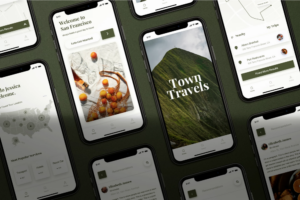In 2016, mobile internet usage finally surpassed computer usage, and the trend has only continued to grow. In fact, according to Statista, mobile usage accounts for approximately half of all web traffic worldwide. In the third quarter of 2020, mobile devices generated 50.81% of global website traffic, and has been hovering around the 50% mark since 2017.
What does this mean for website owners?
This means having a mobile-friendly website is no longer an option, but a requirement. If your mobile visitors don’t have a good user experience, your website will quickly drive traffic away from your website rather than to it.
Besides providing a good experience for your visitors, Google also takes a website’s mobile-friendliness into consideration when assigning search rankings. Any websites that are not mobile-friendly will automatically be moved down in the search results.
So, how do you know if your website is mobile-friendly?
If your website was recently built or updated, you likely have a mobile-friendly website. If you want to be sure, you can use Google’s mobile-friendly testing tool. This tool will not only let you know if your website is mobile-friendly, but it will also show you an image of how it looks on a small screen and provide a list of recommendations to make your mobile experience better.
Even if Google gives you the green light for having a mobile-friendly website, there may still be some changes you can make to enhance your visitor experience.
Here are 8 steps you can take toward a better mobile-friendly website strategy.
1. Responsive Website Design
Google strongly recommends responsive design. Building a responsive website that works well on both mobile and desktop platforms is the best way to ensure a good mobile experience. Responsive websites include all the same content and information on any device used, but the website “responds” to the size of the device’s screen and adjusts how content appears accordingly. For example, an image with some text next to it on a desktop screen may appear stacked on a mobile device due to the smaller screen size.
2. Easy-to-Find Information
When people are searching for something, they want to find the information they are looking for as quickly and easily as possible. Think about what information your visitors are most likely going to be searching for and make sure it can be found easily. Reducing the steps users have to take to find the information they are looking for will make their overall experience on your website better. More positive user experiences lead to a better Google search ranking for your website.
If you’re not sure what your visitors are looking for when they come to your website, use your analytics. In Google Analytics you can add Mobile Traffic as a segment in the Behavior section. This function will let you take a deeper look at how your mobile visitors are interacting with your website.
3. Mobile Speed (Yes, it matters!)
With lightning fast internet speeds these days, no one wants to wait around for a page to load. Google’s research on mobile loading speeds found that your website needs to load in under 5 seconds or visitors will click away. Also, site speed is another ranking factor that Google uses for search rankings.
First, check your mobile website speed and see how it performs. Then, decide how you want to approach improving your site speed. You can use Google’s Mobile Speed Tool to start. Then you can use the MobileTest tool to load your website from a variety of mobile device viewpoints. Be sure to look at your entire site and not just one page!
A few other things to consider include:
- Using Accelerated Mobile Pages (AMP)— AMP is a framework Google encourages for speeding up load times of your web pages on a mobile device. If you have a WordPress site you can use the AMP plugin.
- Compressing your images and CSS— Images tend to be larger file sizes and can take longer to load, so work on compressing your images to improve the page load speed.
- Checking your hosting plan— you may need to upgrade your hosting to what matches your needs or find a more reputable hosting company. Cheaper is not always better, especially when it comes to the slowness of your pages loading on your website.
4. Bye, Bye Pop-Ups
Nobody likes ads or pop-ups that block their view of the page— it’s disruptive. You might think you’ll get more clicks or downloads with a pop-up, but on a mobile device it tends to block the view of content and negatively impact the user experience. If you have to do a pop-up, make it only appear when someone is visiting your site from a desktop. Why? Most visitors won’t take the time to find the X to minimize the pop-up, instead they’ll just click away without viewing any of your website. If you have to have a pop-up for a mobile viewer, make sure the X to cancel is big enough that they can easily find and select it.
5. Keep It Simple
Complicated websites with a lot of information are confusing on any screen, but even more so when viewing the website on a small screen. Avoid this by sticking to a clean, minimalistic design that makes it easy for visitors to find the information they are looking for quickly. Also, a simple design can help your pages load faster since there are fewer files on each page.
Think about this with your navigation as well. If your website has a lot of pages and subpages, you may want to cut the mobile navigation down to the most important options. Many websites offer a mobile “hamburger” menu that works well on smaller screens. That way the navigation isn’t taking up too much space and visitors can open it if they need it.
6. Use Large Font Sizes
Reading on a small screen is even harder if you use a tiny font. Make sure your font size is at least 14px on your website, but feel free to test it out on your mobile device to make sure that it is large enough to read easily. If not, increase the size until you find your desired result.
7. Flash = Bad
Using flash on your website will not only hurt your SEO, but it will also hurt your mobile user experience. It can slow down your page’s load time, and many browsers or devices don’t like and support it. Neither iOS nor Android devices support flash, so using it on your site will cause you to lose out on anyone viewing your website from a mobile device. If you still have any flash on your website, scrap it and find a strong web design that works well without it.
8. Allow the Switch to Desktop View
Some of your mobile visitors may prefer to view your website’s desktop version instead of the mobile version, even on their mobile device. Give them a way to do that. Your visitors should always be able to interact with your website in a way that works best for them.
Ready to get started?
The best thing you can do to make sure your website is responsive and offers a good mobile experience is to regularly test and make improvements as needed. Make sure to pull up your website on your mobile device every so often and spend time browsing to see if anything’s hard to see or difficult to do. Have your friends, family, or employees do some testing as well so you are getting feedback from multiple people on different devices.
Even if you get everything corrected today, the way mobile devices look and work will continue to change. Keep testing, tweaking, and making mobile users a priority.
If you need help analyzing your website’s mobile-friendly ranking, Jennasis and Associates can help! We have a whole team of experts eager to assist you. To get started, email us at digitalmarketing@jennasisassociates.com or fill out our contact form.





